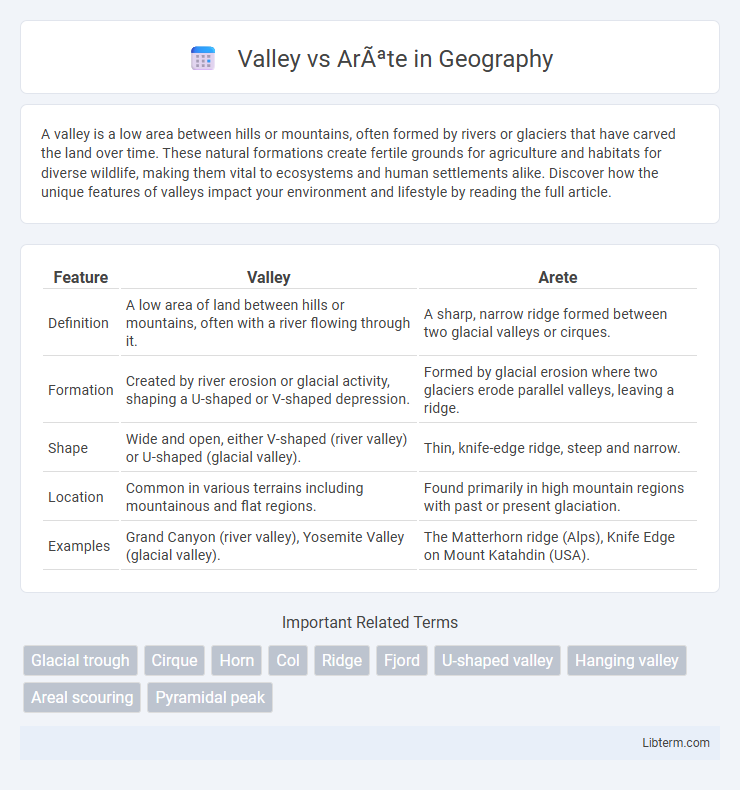A valley is a low area between hills or mountains, often formed by rivers or glaciers that have carved the land over time. These natural formations create fertile grounds for agriculture and habitats for diverse wildlife, making them vital to ecosystems and human settlements alike. Discover how the unique features of valleys impact your environment and lifestyle by reading the full article.
Table of Comparison
| Feature | Valley | Arete |
|---|---|---|
| Definition | A low area of land between hills or mountains, often with a river flowing through it. | A sharp, narrow ridge formed between two glacial valleys or cirques. |
| Formation | Created by river erosion or glacial activity, shaping a U-shaped or V-shaped depression. | Formed by glacial erosion where two glaciers erode parallel valleys, leaving a ridge. |
| Shape | Wide and open, either V-shaped (river valley) or U-shaped (glacial valley). | Thin, knife-edge ridge, steep and narrow. |
| Location | Common in various terrains including mountainous and flat regions. | Found primarily in high mountain regions with past or present glaciation. |
| Examples | Grand Canyon (river valley), Yosemite Valley (glacial valley). | The Matterhorn ridge (Alps), Knife Edge on Mount Katahdin (USA). |
Introduction to Valley and Arête
A valley is a low area between hills or mountains, often formed by river erosion or glacial activity, characterized by its U-shaped or V-shaped cross-section. An arete is a sharp, narrow ridge formed when two glaciers erode parallel valleys or cirques, creating a steep, knife-edge crest. Both landforms are key features in glacial geomorphology, showcasing the powerful impact of ice movement on mountain landscapes.
Defining Valleys: Characteristics and Formation
Valleys are elongated low areas typically formed by erosional processes such as river downcutting or glacial activity, characterized by gentle slopes and a flat or V-shaped floor. They often develop over millions of years through the continuous erosion of rock and soil by flowing water or ice movement, which carves out the surrounding landscape. The distinct shape and size of valleys depend on the dominant erosional forces and the type of rock present, influencing drainage patterns and local ecosystems.
Understanding Arêtes: Key Features and Formation
Aretes are narrow, sharp ridges formed by the erosional activity of two adjacent glaciers carving parallel valleys, typically found in mountainous regions. Their distinct knife-edge profile results from the headward erosion of cirque glaciers on both sides, which steepen and isolate the ridge. Understanding aretes involves recognizing their geological importance as indicators of past glacial movement and their role in shaping rugged alpine landscapes.
Geological Processes Behind Valleys
Valleys form primarily through erosion by rivers that cut deeply into the earth's crust, carving U-shaped or V-shaped depressions depending on glacial or fluvial activity. Aretes, sharp ridges found in mountainous regions, are created by the headward erosion of two adjacent glaciers that carve parallel valleys. The geological processes shaping valleys involve both mechanical weathering and sediment transport, while aretes result from the sculpting force of glacial ice grinding against rock.
Glacial Erosion and the Creation of Arêtes
Glacial erosion shapes valleys through the process of plucking and abrasion, carving U-shaped cross-sections in mountainous terrain. Aretes form when two adjacent glaciers erode parallel valleys, their sides steepening and sharpening the ridge between them. The intense glacial scouring and freeze-thaw action enhance the narrow, knife-edge profile characteristic of aretes.
Visual Differences: Valley vs Arête
Valleys are broad, elongated depressions typically formed by river erosion or glacial activity, characterized by gently sloping sides and a flat or concave floor. Aretes, in contrast, are sharp, narrow ridges formed by the erosion from two adjacent glaciers carving parallel valleys, resulting in steep, knife-edge crests. Visually, valleys appear as wide, open spaces with smooth contours, while aretes stand out as jagged, dramatic features separating steep-sided landscapes.
Key Examples of Famous Valleys and Arêtes
The Grand Canyon in Arizona exemplifies a spectacular valley carved by the Colorado River, showcasing deep, layered geological history. The Matterhorn, straddling the Swiss-Italian border, is a renowned arete distinguished by its sharp, knife-edge ridge formed through glacial erosion. Yosemite Valley in California illustrates a classic U-shaped glacial valley, while the Knife Edge on Mount Katahdin in Maine is a famous arete noted for its steep, narrow rock ridge.
Ecological Significance: Valley and Arête Landscapes
Valleys provide critical habitats for diverse flora and fauna due to their nutrient-rich soils and water availability, supporting complex ecosystems in contrast to the harsher, less vegetated environments of aretes. Aretes, formed by glacial erosion, serve as natural corridors for alpine species and influence local microclimates by directing wind patterns and snow accumulation. Both landforms contribute uniquely to regional biodiversity and ecological connectivity within mountainous landscapes.
Valley and Arête in Outdoor Recreation and Adventure
Valleys in outdoor recreation offer accessible terrain for hiking, camping, and wildlife observation, often featuring rivers and lush vegetation that support diverse ecosystems. Aretes, formed by glacial erosion, provide challenging ridges favored by experienced climbers and mountaineers seeking thrilling exposure and panoramic views. Both formations contribute uniquely to adventure activities by shaping distinctive landscapes that attract enthusiasts for varied outdoor experiences.
Conclusion: Valley vs Arête – Summary of Differences
Valleys are elongated depressions typically formed by erosion from rivers or glaciers, characterized by their U-shaped or V-shaped cross-sections, whereas aretes are narrow, sharp ridges created by the erosion of two adjacent glaciers. Valleys often serve as natural pathways and support diverse ecosystems due to their broader, flatter floors, while aretes are prominent geological features that signify rugged mountainous terrain. Understanding the differences between valleys and aretes aids in interpreting landscape formation and geological history.
Valley Infographic

 libterm.com
libterm.com